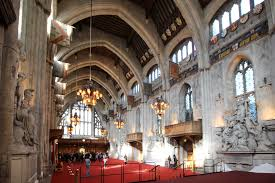So there I was, wilting under the monstrous stern gaze of both Gog and Magog, the giant guardians of the City of London, when I was reminded that of course they're statues, but my oh my they're fierce and in a way all the more frightening when you're stood in the vast medieval empty space of the Great Hall. This is where I found myself a week ago, following a visit to the Police Museum at the Guildhall London. A speculative inquiry by my husband, as to if it was possible to take a look inside the famous building, turned into a fantastic private tour, taking in the Great Hall, the East & West Crypts, Chief Commoners Parlour, the Old Library, the Livery Hall and an encounter with some Romans.
The security staff could not have been kinder and more helpful, clearly there was the initial security checks on bags and belongings, but after they had satisfied themselves that we had no malicious intent, they set about ensuring we had time to appreciate the splendour of the Grade 1 listed landmark. And it does not disappoint, its history immediately impacts on you as soon as you enter its most famous area - The Great Hall. After one has regained their composure following the inevitable gasp of wonderment on entry, a discerning eye will note that not all is medieval original. Despite the Luftwaffe's attention in 1940 the 800 year old walls, window traceries and monuments that have been added over generations survived, testament indeed to the builders of the time. The structure was rebuilt to the original plan; however like most historic buildings, the Great Hall as we see it today, has evolved. My dawdle around the periphery of the huge chamber noted statues and monuments to Nelson, Wellington, Pitt the Elder, Pitt the Younger and of course Winston Churchill. These great national heros and statesmen have been added to even earlier mentions of the Nine Days Queen - Lady Jane Grey, an Archbishop and Peers of the Realm being tried for Treason during the Reformation.
At the Western end of the Hall Gog and Magog monitor proceedings from their lofty perch on a gallery. Legend has it that this pair of giants were defeated by Brutus of Troy and chained to the gates of his Palace on this site. Despite their size and stature, the original pair were destroyed in the Great Fire of London in 1666 and were replaced in 1708. Unfortunately these in turn succumbed to the German Blitz and were again replaced with the current incumbents in 1953. The chamber is truly cavernous and visions of the glittering State Banquets everyone has seen on the news, flit past your eyes as you take the place in. Though these occasions are clearly lit with precision, the chamber floods with natural light via the two huge Gothic windows at either end of the room. The Pomp and Colour of the place is further enhanced by the adornment of the banners of London's 12 great Livery companys, high up between the side windows, which themselves are emblazoned with the names of Lord Mayors.
After the awe-inspiring splendour of the Great Hall, we descended a short flight of stairs to enter the nominal gloom of the Crypts. That is to say they are lit to enhance the architectural features found there and not that they are any the less impressive. Our guide informed us that some of the scenes filmed for the recent BBC production - Apple Tree Yard, were done here, standing in as it was for Westminster. Our next port of call was the Livery Hall, which itself is a much later addition to the Guildhall complex, being built between 1870 and 1873. Whilst the area lacks some of the historical gravitas of its famous neighbour, it is nevertheless an imposing area and must be magnificent when presented for the many corporate functions which take place here. The Old Library was at once welcoming and grand, boasting huge paintings of occasions past and that real sense of 'if only walls could talk'. Our final destination was the Chief Commoner's Parlour; a surprisingly intimate room following the grandeur of the other areas we had passed through, but still inspiring enough to give one the impression they had strayed onto the set of Hogwarts. The Office of Chief Commoner persists to this day and is an elected position for 12 months - who wouldn't want it when you get your own parlour at the Guildhall!
Our helpful impromptu guide suggested we head across the square to the Guildhall Art Gallery. He informed us that during the construction of the new building in 1999, a Roman Amphitheatre was discovered on the site. We hot-footed across and sure enough to our amazement about a third of the original Roman structure had been unearthed. Visitors to the gallery are able to descend to the Amphitheatre and actually walk amongst the ruins which lie directly below Guildhall square. On the discovery of the ancient site during excavations for the new art gallery, architects had to work to alter the design and construction to accommodate something of such importance into the overall plan. The result is both astonishing and educational and up above in the square itself a huge circle can be seen in the pavement, indicating the circumference of the Amphitheatre below. It is well known and documented that the site of the current day Guildhall was important and had been in use prior to the current medieval structure and adjacent buildings, but this discovery confirmed suspicions about the significance of the area going back much further than may have been supposed.
We left the Guildhall and ambled across to a local coffee shop to take stock, with me reflecting that the visit was an unexpected privilege and well worth enduring the withering stare of Gog and Magog!


